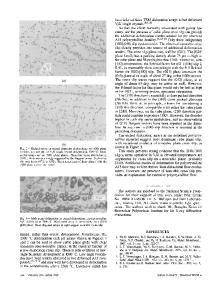Crystallization of A15 Nb 3 Ge from the amorphous state
- PDF / 1,244,366 Bytes
- 6 Pages / 593.28 x 841.68 pts Page_size
- 78 Downloads / 347 Views
Crystallization of A15 Nb3Ge from the amorphous state Marcin Wardak and Mireille Treuil Clapp Department of Mechanical Engineering, University of Massachusetts, Amherst, Massachusetts 01003 (Received 7 August 1989; accepted 1 November 1989) The critical current density Jc of superconductors is strongly dependent on microstructure. The microstructure and crystallization of amorphous Nb75Ge24.5Bo.5 melt spun ribbons were studied as a function of 24-h anneals between 680 and 860 °C. Metastable A15 was formed with a composition close to that of the starting amorphous material. As the temperature increased from 680 to 720 °C, crystallization remained nonuniform and the average grain size decreased from 130 nm to 60 nm. Between 740 and 800 °C crystallization was uniform and the average grain size was constant at 30 nm. Above 820 °C grain growth occurred. In order to have high /c's a uniformly crystallized small-grained material is desirable.
I. INTRODUCTION
The material studied in this research, Nb3Ge, belongs to the A15 group of superconducting materials capable of carrying very high currents at high magnetic fields. The most promising A15 for commercial applications is Nb3Sn, and it has a critical current density Jc of the order of 109 A/m2 at 15 Tesla, which drops off rapidly at higher magnetic fields. For special applications such as nuclear fusion reactors and supercolliders there is a need to find a material capable of sustaining high/c's up to 20 T. Metastable stoichiometric Nb3Ge is a possible candidate because of its relatively high critical temperature, Tc (23 K), and upper critical magnetic field, Hc2 (38 T). However, this material is difficult to process into wire form not only because of the extreme brittleness of A15s, but also because of its inherent metastability. Recently one of the authors applied a novel processing technique to this alloy to form continuous A15 Nb3Ge tapes via the amorphous state.1 The new technique was based on making amorphous material by melt spinning and then developing a fine grain structure using appropriate heat treatments. Jc was strongly dependent on microstructural features such as degree of crystallinity, grain size, and second phase precipitates. For uniformly crystallized small-grained material of -30 nm, /c's at 4.2 K were 8 x 1010 A/m2 and 5 x 1010 A/m2 at 0.5 and 15 T, respectively. The conclusion of the research was that in order to optimize the microstructure and enhance Jc, a detailed study of the crystallization of the A15 Nb3Ge from the amorphous state was required. Samples of melt spun amorphous Nb75Ge24.5Bo.5 ribbons were provided for this study.1 A small amount of B (0.5 at. %) was added to the alloy to facilitate the formation of the amorphous phase. Details of the fabrication process can be found in Ref. 1. Ribbons were typically 0.5 to 0.8 mm wide and 10 \L thick. They were 478
http://journals.cambridge.org
J. Mater. Res., Vol. 5, No. 3, Mar 1990
Downloaded: 13 Mar 2015
formed by ejecting molten material through a narrow orifice onto a rapidly rotating
Data Loading...











